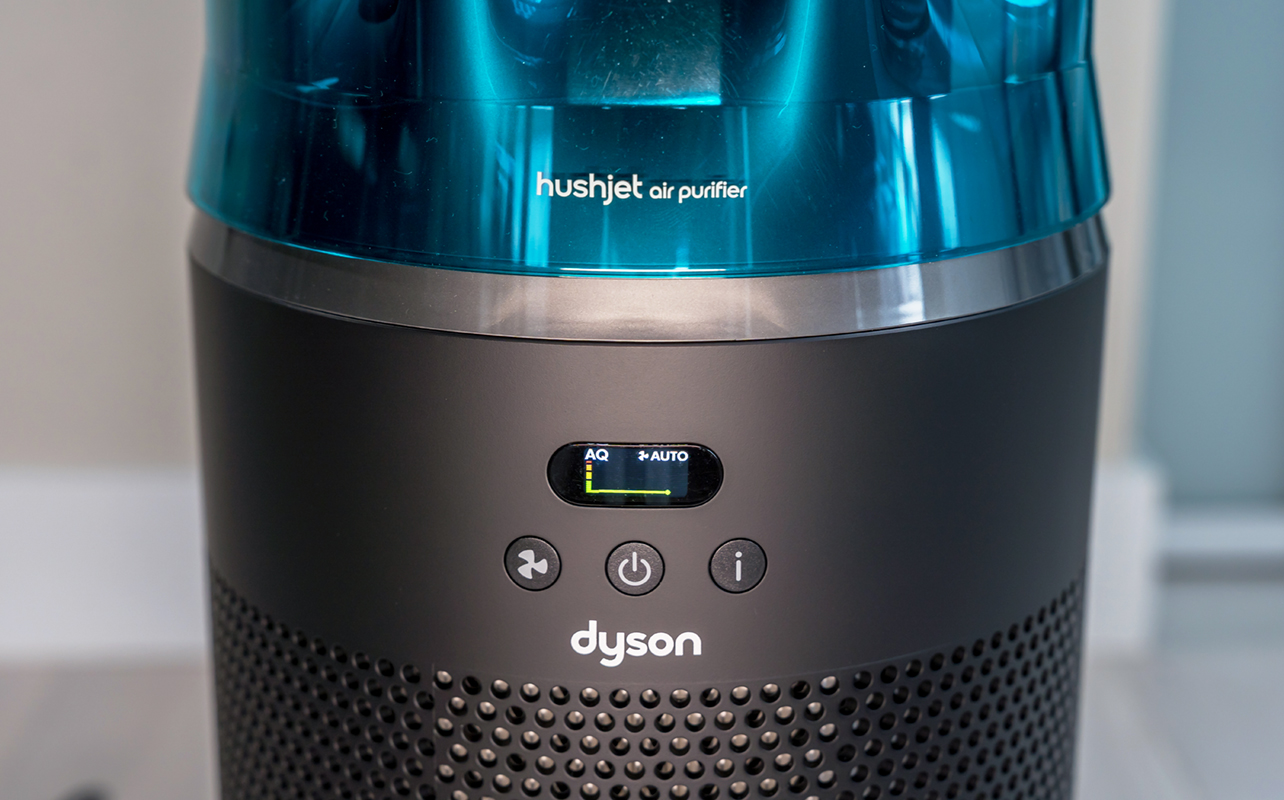
Clearing the air takes on a unique perspective when it comes to what you’re breathing at home, and that’s where the Dyson HushJet Air Purifier comes in. You can’t officially call this an appliance but it functions a lot like one because of its utility.
For starters, this is not a whole-home air purifier. Its compact size and quieter operation make it more suitable for bedrooms, home offices, nurseries, and smaller living spaces, like dorms or studio apartments. Easy to set up and monitor, it’s very much a “set it and forget it” type of product, though it can also tell you a lot about the air you live with.
What the design means
When you use the word “hush” and “jet” in a product, it feels like a contradiction in terms. Jets are loud, and while Dyson took inspiration from jet engines to design the upper portion of this unit, it rarely ever comes close to roaring like one.
Dyson’s lineup of air purifiers are generally bigger and more powerful, and their associated cost makes them a tougher sell. The HushJet doesn’t take up as much room and costs less, so it has a more attractive entry point.

The HushJet is about 18 inches tall and 9 inches wide and doesn’t need much upkeep. It also weighs just under 7 pounds, making it portable enough to move when necessary. It can effectively cover up to 203 sq. ft. of space, which should be enough for most rooms. Dyson says it built the star-shaped nozzle at the top to push air out and circulate with as little noise as possible.
The cylindrical base has two filters inside: an activated carbon filter and electrostatic filter. One just slides into the other but they’re already in place inside the unit when you first take it out of the box. Maintenance is pretty standard here, with Dyson recommending you replace the carbon filter every 12 months and the electrostatic one every five years. Since the company doesn’t often change filter dimensions for its products, it likely won’t be hard to find five years down the line.
Simple setup and operation
You can get the HushJet up and running in mere minutes by taking it out of the box and plugging it in. It just starts up and activates the filters to do their thing. Add it to your Wi-Fi network and it then becomes a connected device. The onboard screen shows the air quality level and captured pollutants (though it takes a little time to initially get a fully accurate reading) in both a colour-coded graph and number.
It’s best to place the unit out of the way but not necessarily obstructed. For it to be effective, it needs some clearance to capture the microns lurking in the air around you. If space is more limited, I would advise keeping an inch or two of space between the unit and the wall to ensure it can catch and release air unimpeded. You can still put it in a corner because its vertical orientation means the walls around it aren’t blocking anything.

From here, pairing the HushJet with the MyDyson app on iOS or Android is pretty straightforward. If you already have a Dyson account and other products in your account, then it takes even less time. If you don’t, setting up an account is fairly straightforward.
Once paired, you can control a few different aspects of the air purifier, be it the fan’s airflow or a timer to turn it off after a set period. Unlike Dyson’s other air purifiers, there aren’t more advanced features or settings. The app is particularly useful when it comes to information and maintenance, complete with how-to videos showing how to set it up, clean it, and replace the filters.
Control it with your voice
Since this is a smart device, you can also control it with Alexa or Google Assistant. For Apple users, only Siri Shortcuts work. If you already have other smart home devices set up on either platform, adding the HushJet will be straightforward. If it’s your first, you follow the steps to add a Dyson device through the Alexa or Google apps and you’ll be good to go.
This means you can control the device from anywhere, not just at home. If, for instance, you’re on your way home from work and have access to either voice assistant, you can turn up the fan to circulate the air before you arrive. It doesn’t push out hot air, so it won’t help warm things up in a room, but if your place tends to get a little stale during the day, this is one way to help. Same with travelling, where setting up a timer or routine can help circulate air inside while you’re gone.
You can also do this through the app, but the convenience of simply turning the device on by voice is easy to appreciate. That’s especially true if you’re in the car driving home or want to see what air quality looks like in the room you’ve placed it in.
Keeping the air clean

Dyson built the HushJet to capture the kind of microscopic pollutants your eyes can’t see. These can be as small as 0.3 microns and include common allergens that might irritate your sinuses. Consider that specks of dust and microbes can be as small as 0.3 microns, so negating their proliferation makes sense if you spend a lot of time at home. While Dyson makes no claims to mitigating viral droplets to keep you from getting sick, my own experience with air purifiers tells me they can make a difference.
I personally don’t have pets but I see the benefits of using an air purifier if you do. Pet owners can feel the effects of pet dander circulating by itching or sneezing, and the HushJet can minimize that. Airflow can differ by a home or room, so it’s hard for me to quantify the true impact but this device really goes to work when air quality changes inside.
Think of candles, cooking, smoking, or blow-drying hair. My review unit (in Auto mode) really sprang into action with both activities, showing an increase in pollutants and pushing cleaner air through its vent. Dyson’s air multiplier technology is a staple of its fans and vacuums, where air funnels through a smaller opening to increase the pressure and velocity.
In addition, the inside wisely seals off the filters from the rest of the unit in that air coming out of the vent isn’t contaminated by the very microns it picks up. The thing is, if your home is generally dusty or poorer in airflow, you will most likely have to replace the filters sooner. The MyDyson app is helpful there because it monitors filter health, giving you a heads up if you need to swap one out.
Where does it make the most sense?

As someone who works from home, I have to take indoor air quality seriously. When wildfire smog made air quality terrible outside this past summer, it seeped inside as well, so made sure to keep my purifiers active throughout. There were no similar conditions while testing the HushJet but living in a big city means every home is exposed to common pollutants. Keeping them away is worth it.
That’s why I can see this appealing to different needs. Elderly relatives and infants stand out, as do pet owners and work-from-home situations. If sinuses become an issue during sleep, the HushJet could help, especially in tandem with a humidifier. Its Sleep mode goes as quiet as 24 dB—barely registering as a whisper. That’s why it’s not likely to disturb babies or young kids. Nor would it disturb you in a home office.
What I particularly liked was being able to move it from room to room at will. The app asks you to assign it to a room, which can matter when controlling it as a smart home device, but you’re not obligated to always keep it in one place. After all, it’s only good for one room, not a full home, so it might be necessary to move it anyway.
Final thoughts
It doesn’t hurt that both colorways are attractive. Neither unit will look weird or wacky in any room you want to put it in. I recognize it’s a pricey proposition given it’s a tech product that you don’t interact or play with. Indeed, it’s at its best when you always see a green line and number on it. But if you feel like air quality is a problem in your home or room, or respiratory health is a concern, this might be a way to deal with it in a more constructive way.
The Dyson HushJet Air Purifier is available now in white/silver or black/teal. Check out all of the latest Dyson gear available now.





